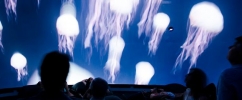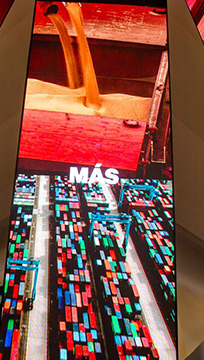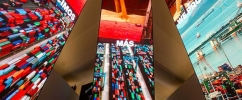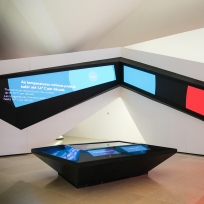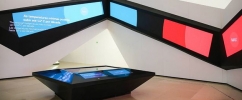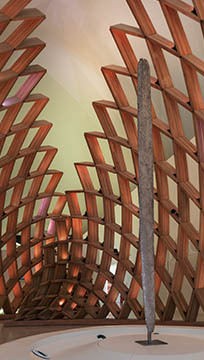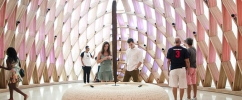Earth

After exploring the Universe, visitors discover the unique conditions that fostered life on the planet along with the development of human intelligence and culture in the second area on the museum itinerary: the Earth. Here, visitors experience the realms of “Matter”, “Life” and “Thought”. Matter organizes to form life, out of which develops thought, which in turn enables the study and understanding of matter and life.
“It is as if man were the vehicle for the Earth’s thoughts,” says Luiz Alberto Oliveira. Each of three 7x7-meter cubes relates to one element. The exterior of the cubes represents unity, showing commonalities of humanity, while the interior deals with diversity. Interactive tables offer more indept content.
Matter
One hundred and eighty images of Earth from space cover the exterior of the Matter cube. The images of the planet in its entirety remind us of the angle that Russian astronaut Yuri Gagarin first saw – and showed- in his space flight.
The interior of the cube features an installation by the American artist Daniel Wurtzel. The piece is a poetic representation of the components of the climate of the planet. Dancing fabric mirrors the slow movement of the tectonic plates, the graceful rhythm of the seas, air speeding through the atmosphere and the impressive velocity of the sun’s light. “The fabric flowing freely, with no apparent means of propulsion, creates a magical atmosphere,” says Wurtzel, who has created works for Cirque du Soleil, the Smithsonian Institution and Louis Vuitton. This is his first work shown in Brazil.
Life
“DNA is the genetic material of all living things. That is why it is called the molecule of life,” explains biologist Eliana Dessen, a consultant for the museum. Because DNA is the language in which all life on Earth is written, the metal plates covering the cube are decorated with the letters of the four parts of deoxyribonucleic acid, adenine (A), cytosine (C), guanine (G) and thymine (T), interspersed with inspirational phrases about the museum and the names of the essential proteins of the human body. An infinite number of species and related ecosystems have emerged from DNA.
The interior of the cube features 200 photos and videos of the rich biodiversity of the Bay of Guanabara. They show the six aspects of the ecosystem in which the Museum of Tomorrow is situated: high altitude fields, highland forests, lowland forests, the coast, mangroves and the waters of the bay. From the peak of the Pedra do Sino in the Serra dos Orgãos National Park to the waters surrounding Paquetá Island, the photos capture rare sights such as grey porpoises, golden lion tamarins and the ‘saudade’ bird. “Even with the disorderly growth of the region, there are still protected areas that are little oases,” states Christian Dimitrius, a biologist, photographer and filmmaker who took over 10,000 photos on the expedition for this project. The images are shown in mini-documentaries and interactive displays in which visitors can learn about the interconnections within an ecosystem and how imbalance affects the entire system.
Mind
Diversity gave rise to mankind and thought. The images on the exterior of the third cube represent different brain activities. “Because of the brain’s neuroplasticity it is in a constant state of transformation, a result of the person’s life and what occurs in that life; of the world in which s/he lives and what is imposed by the world. The brain reacts to both physical and symbolic stimuli,” explains Benilton Bezerra Jr., a psychiatrist and consultant to the museum. While brain functions are common to all of humanity, the amount of diversity that has emerged from the brain is immense. This diversity is shown in a labyrinth of over a thousand images from all around the world of how human beings celebrate, live, love, speak, eat, dress, and have conflicts.

